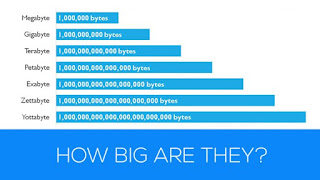Everything you need to know about Terabytes, Gigabytes, Petabytes and Other Storage Metric terms.
What is a terabyte? How many gigabytes of storage does a device or memory card contain? These are few out of the many questions that come up when a new digital device, hard drive, or memory card is about to be purchased. As common as these data storage metric terms are, it is safe to say that many people still have no clue what they are.
So before you go ahead to purchase a hard drive or flaunt your technological know-how in the face of your friends, it is important that you consider what these metric terms mean, their sizes when compared to one another, and much more. The good news here is, these terms are not as complicated as they sound.
The illustrations contained in this article are simple and soon you’d be an expert in converting these metrics from one to another and also have basic knowledge about what they mean.
WHAT ARE THE DATA STORAGE METRIC TERMS AVAILABLE?
This is a familiar question but for the sake of the newbies, the terms are Exabyte, petabyte, terabyte, gigabyte, megabyte, kilobyte, and byte. Features to note here are the sizes, and common abbreviations. All you need to do to get the right abbreviation is to pick the first letter of the term and add “B” which stands for byte to it, for example, Gigabyte is GB, Terabyte is TB and so on. “Byte” is common to all of these terms because it is the amount of storage space required to accommodate a character of text. You can view it as the “cell” of storage terms, it is quite important.
Well, another term that comes to mind is “bit”. If a byte is a storage space, what then is a bit all about? You can consider it to be smaller than a byte because 8 bits make up 1 byte. Adding more to this simple illustration will probably get you confused, so let’s leave it at that.
WHICH DATA STORAGE METRIC TERM IS THE LARGEST?
It is easy to work this out, all you need to do is determine which is the largest and then work your way down from there. An exabyte is currently the biggest and it followed in a downward progressing manner by petabyte, terabyte, gigabyte, megabyte, kilobyte and then byte. Quite simple isn’t it?
HOW DO I CONVERT SIMPLE DATA STORAGE METRIC TERMS?
Based on how computers work, each storage metric term differs from the next by 1024. This may contradict what you must have heard about this conversions before but it is true and probably the most realistic multiplier that you can use to carry out your calculations.
With that said, 1TB will contain exactly 1024GB, a further breakdown will give 1,048,576MB and so on. This means that you can get the value of 1TB in GB by multiplying it by 1024 and also get the reverse by dividing by 1024 also.
You would notice we didn’t start the conversion with Exabyte; this is because most hard drives and storage devices are currently measured in terms of terabytes, gigabytes, megabytes, and kilobytes. In case you are already asking that question, that should satisfy your curiosity.

Comments
Post a Comment